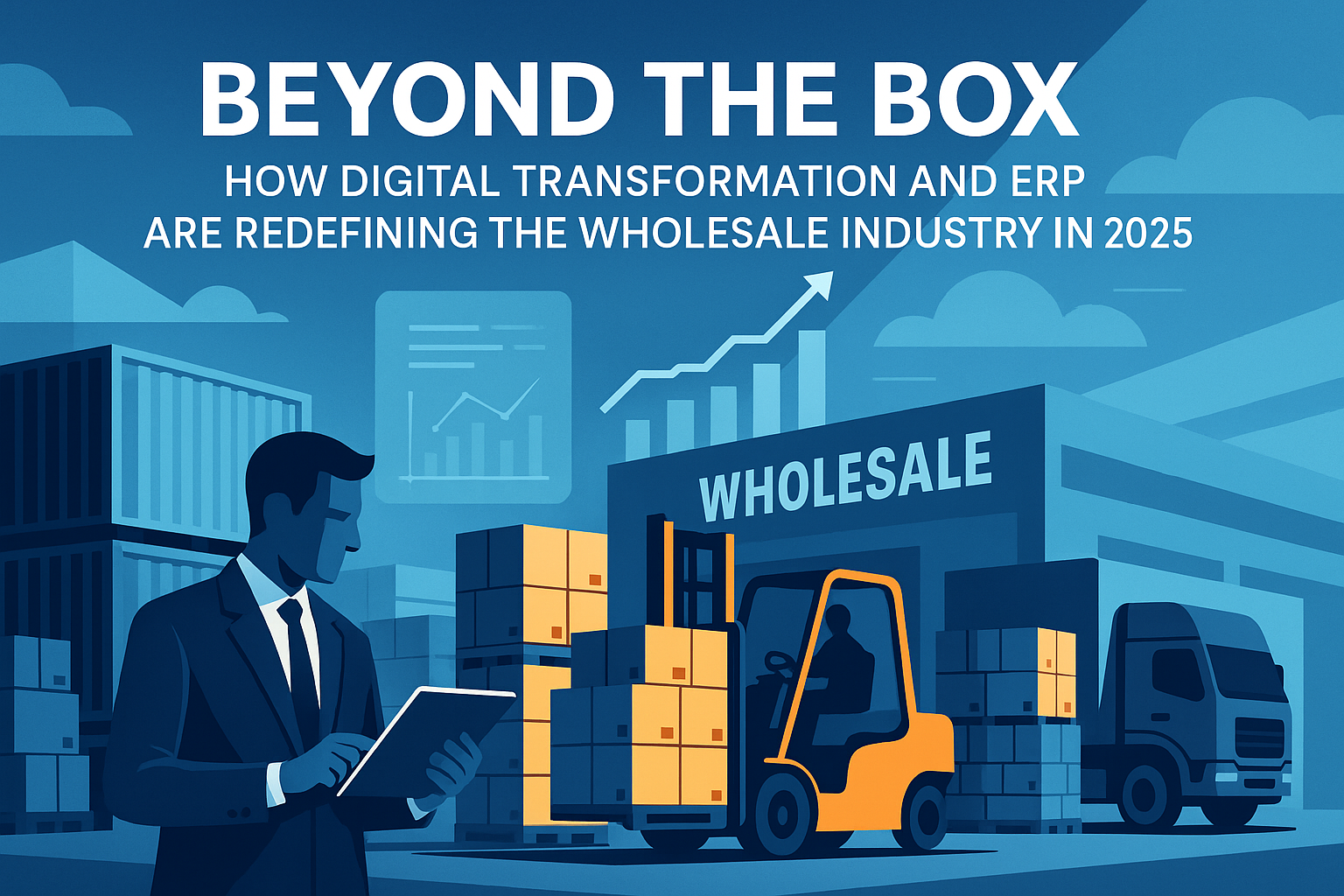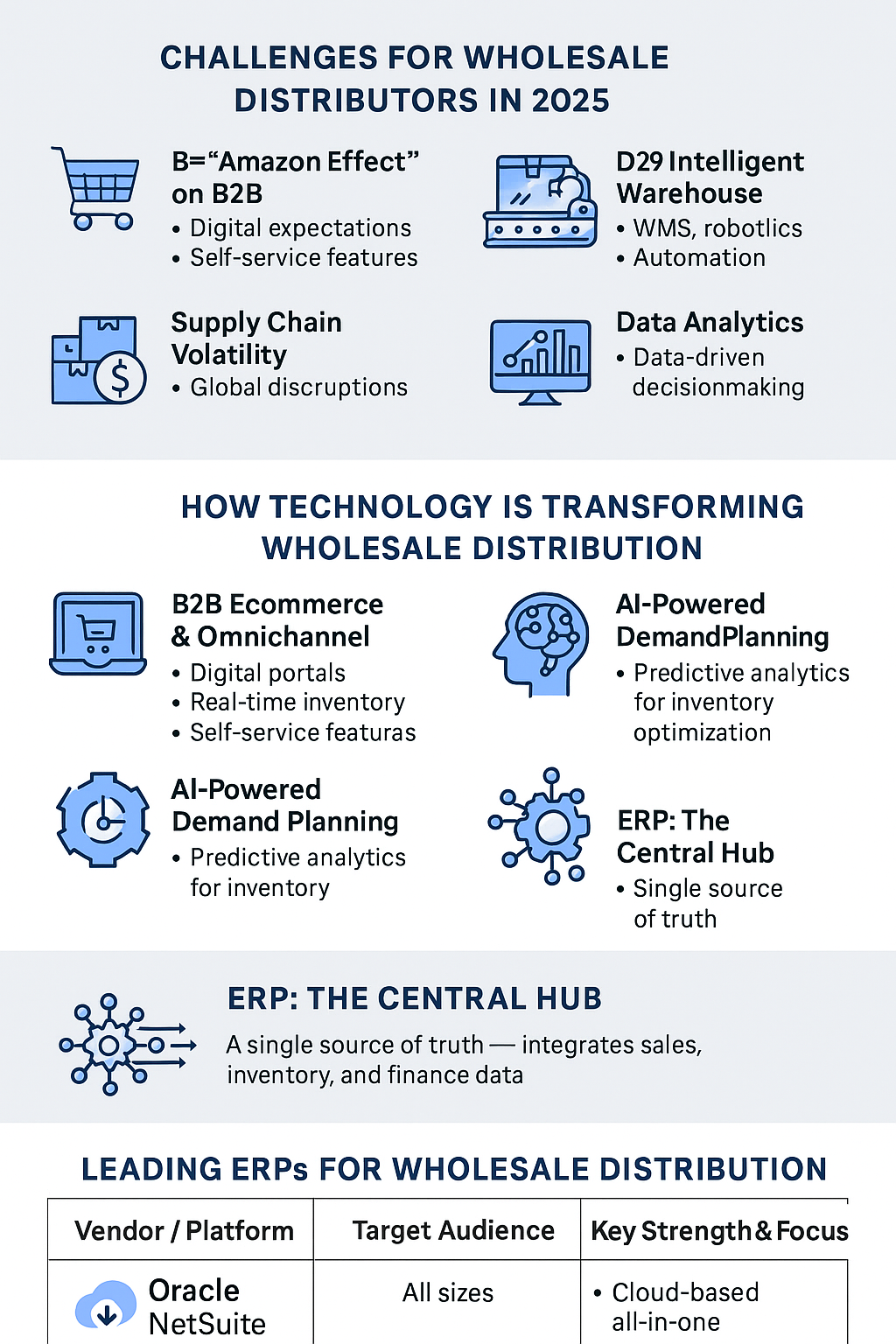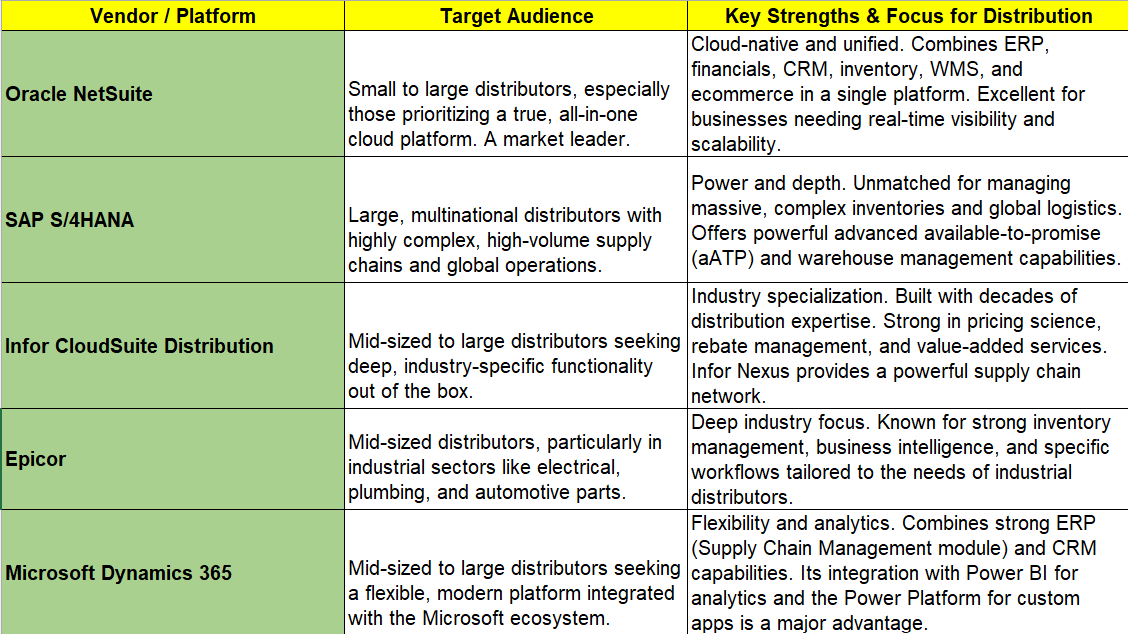Beyond the Box: How Digital Transformation and ERP are Redefining the Wholesale Industry in 2025
2025-08-13 · By Anil Kancharla · 7 min read
❤️ 0 Likes · 👁️ 0 Views
 AI-generated image for illustration purposes only.
AI-generated image for illustration purposes only.
Beyond the Box: How Digital Transformation and ERP are Redefining the Wholesale Industry in 2025
 AI-generated image for illustration purposes only.
AI-generated image for illustration purposes only.
Beyond the Box: How Digital Transformation and ERP are Redefining the Wholesale Industry in 2025
At the heart of this intricate dance of commerce lies the wholesale distribution industry—the critical, often invisible, link between the manufacturers who create products and the retailers and businesses that sell them. For decades, the wholesaler's model was simple: buy in bulk, store it, and sell it in smaller quantities at a margin.
Today, that model is under siege. In 2025, wholesalers are navigating a perfect storm of challenges: unrelenting pressure from e-commerce giants, volatile global supply chains, shrinking profit margins, and a new breed of B2B customer that demands a frictionless, digital-first experience. Simply being a middleman is no longer enough.
The path forward—the only path to survival and profitable growth—is through reinvention. This reinvention is being driven by digital transformation, a top-to-bottom reimagining of operations. And the engine powering this entire transformation, the single source of truth that connects every product, person, and process, is modern Enterprise Resource Planning (ERP) software.
This in-depth blog post will explore the state of the modern wholesale distribution industry, uncover the immense opportunities of its digital evolution, and provide a comparative analysis of leading ERP solutions that are helping distributors become the agile, value-added partners of the future.
The Pressured Pipeline: Challenges Facing Wholesale Distributors in 2025
The ground has fundamentally shifted beneath the feet of wholesale distributors. The core challenges they face today are not cyclical; they are structural changes to the nature of commerce.
- The "Amazon Effect" on B2B: Business buyers now expect the same experience they get as consumers: intuitive online ordering, real-time inventory visibility, personalized recommendations, and fast, reliable shipping. The days of relying solely on phone calls and faxed purchase orders are over.
- Intense Margin Squeeze: Competition is coming from all sides. Large online marketplaces are encroaching on their territory, and more manufacturers are exploring Direct-to-Consumer (D2C) models, threatening to cut out the distributor entirely. This makes every basis point of operational efficiency critical.
- Supply Chain Volatility: Global disruptions have become the new normal. Wholesalers are on the front lines, dealing with supplier delays, unpredictable lead times, and fluctuating shipping costs, making accurate demand forecasting and inventory management more complex than ever.
- Inventory Complexity and Cash Flow: A distributor's cash is tied up in its inventory. Carrying too much inventory (overstocking) drains capital and increases carrying costs, while carrying too little (stockouts) leads to lost sales and damaged customer relationships. Managing tens of thousands of SKUs without advanced tools is a high-wire act.
- Labor Shortages: Finding, training, and retaining skilled warehouse staff and drivers remains a significant operational hurdle, driving up labor costs and impacting fulfillment capacity.
The Digital Pivot: How Technology is Rewriting the Wholesale Playbook
Digital transformation provides a powerful toolkit to combat these pressures, enabling distributors to become more efficient, intelligent, and customer-centric.
-
B2B Ecommerce & The Omnichannel Experience: The modern distributor needs a robust B2B ecommerce portal that is more than just a digital catalog. It must offer customer-specific pricing, real-time inventory levels, easy reordering, and self-service account management. This digital storefront becomes a 24/7 sales channel, freeing up sales reps to focus on strategic relationships rather than simple order-taking.
-
The Intelligent Warehouse (WMS & Automation): The warehouse is no longer just a cost center; it's a strategic asset. Digital transformation here includes:
- Warehouse Management Systems (WMS): A WMS optimizes every process inside the four walls, from intelligent receiving and put-away to optimized picking paths (e.g., wave picking, zone picking) and automated shipping verification.
- Automation & Robotics: Autonomous Mobile Robots (AMRs) can transport goods to human pickers, reducing travel time. Automated packing systems create perfectly sized boxes, saving on shipping costs. Voice-picking technology provides hands-free instructions to warehouse staff, increasing accuracy and speed.
-
AI-Powered Demand Planning and Inventory Optimization: This is the evolution from reactive to predictive inventory management. AI and machine learning algorithms can analyze historical sales data, seasonality, market trends, and even external factors like weather forecasts to predict future demand with stunning accuracy. This allows for automated replenishment, reduces stockouts, and optimizes inventory levels across multiple warehouses.
-
Data Analytics: From Gut Feel to Data-Driven Decisions: Data is a distributor's most underutilized asset. By leveraging business intelligence (BI) and analytics tools, distributors can uncover deep insights, such as: which customers are the most profitable, which product lines have the highest margins, where supply chain bottlenecks are occurring, and how to optimize sales territories.
The Central Hub: ERP as the Engine for Wholesale Distribution
All these digital innovations—ecommerce platforms, WMS, AI forecasting tools—are incredibly powerful. But they create a new problem: more data silos. The true power is unleashed when they are all connected to a central, unified platform. This is the role of an Enterprise Resource Planning (ERP) system built for distribution.
A modern distribution ERP is the single source of truth for the entire business. It ensures that the sales team, the warehouse crew, the purchasing department, and the finance team are all working from the same real-time data.
Core Benefits of a Distribution ERP:
- A Single Source of Truth for Inventory: The ERP provides real-time, enterprise-wide visibility of inventory—what’s on hand, what’s in transit, what’s committed to orders, and what’s on backorder. This is the bedrock of accurate B2B ecommerce and reliable customer service.
- Streamlined Order-to-Cash Process: From the moment a sales order is created (whether via a sales rep, EDI, or the ecommerce portal) to the final cash receipt, the ERP automates and manages the entire lifecycle, including credit checks, fulfillment, invoicing, and collections.
- Integrated Warehouse Management: Whether the WMS is a module within the ERP or a tightly integrated best-of-breed application, the ERP ensures seamless data flow. When an order is approved, it automatically generates a picklist in the warehouse; when it’s shipped, the ERP automatically triggers the invoice.
- Intelligent Procurement and Supplier Management: The ERP uses demand planning data to suggest or automate purchase orders, helping to maintain optimal stock levels. It also manages supplier contracts, pricing, and performance.
- 360-Degree Customer and Profitability Insights: By combining CRM, sales, and financial data, the ERP can provide a complete view of every customer relationship and calculate the precise profitability of every order, customer, or product line.
Selecting Your System: A Look at Leading ERPs for Wholesale Distribution in 2025
The ERP market offers many options, but several are specifically tuned for the high-volume, thin-margin world of wholesale distribution.

The Future is Value, Not Volume
The role of the wholesale distributor is irrevocably changing. The survivors and thrivers of this new era will not be the ones who simply move the most boxes. They will be the ones who leverage technology to become indispensable value-added partners to their suppliers and customers. They will provide seamless digital experiences, intelligent inventory solutions, and flawless logistics.
By embracing digital transformation and building their business on the solid foundation of a modern ERP system, wholesale distributors can move beyond the box, navigate the pressures of the modern market, and solidify their critical place in the future of commerce.
💌 Enjoyed this article?
If you found this post valuable, subscribe to my newsletter for more insights on digital transformation, AI, and business innovation.
👉 Subscribe to the newsletterOr let’s connect on LinkedIn — I share weekly content that’s practical for CIOs, CFOs, and transformation leaders.
🔗 Connect with me on LinkedIn